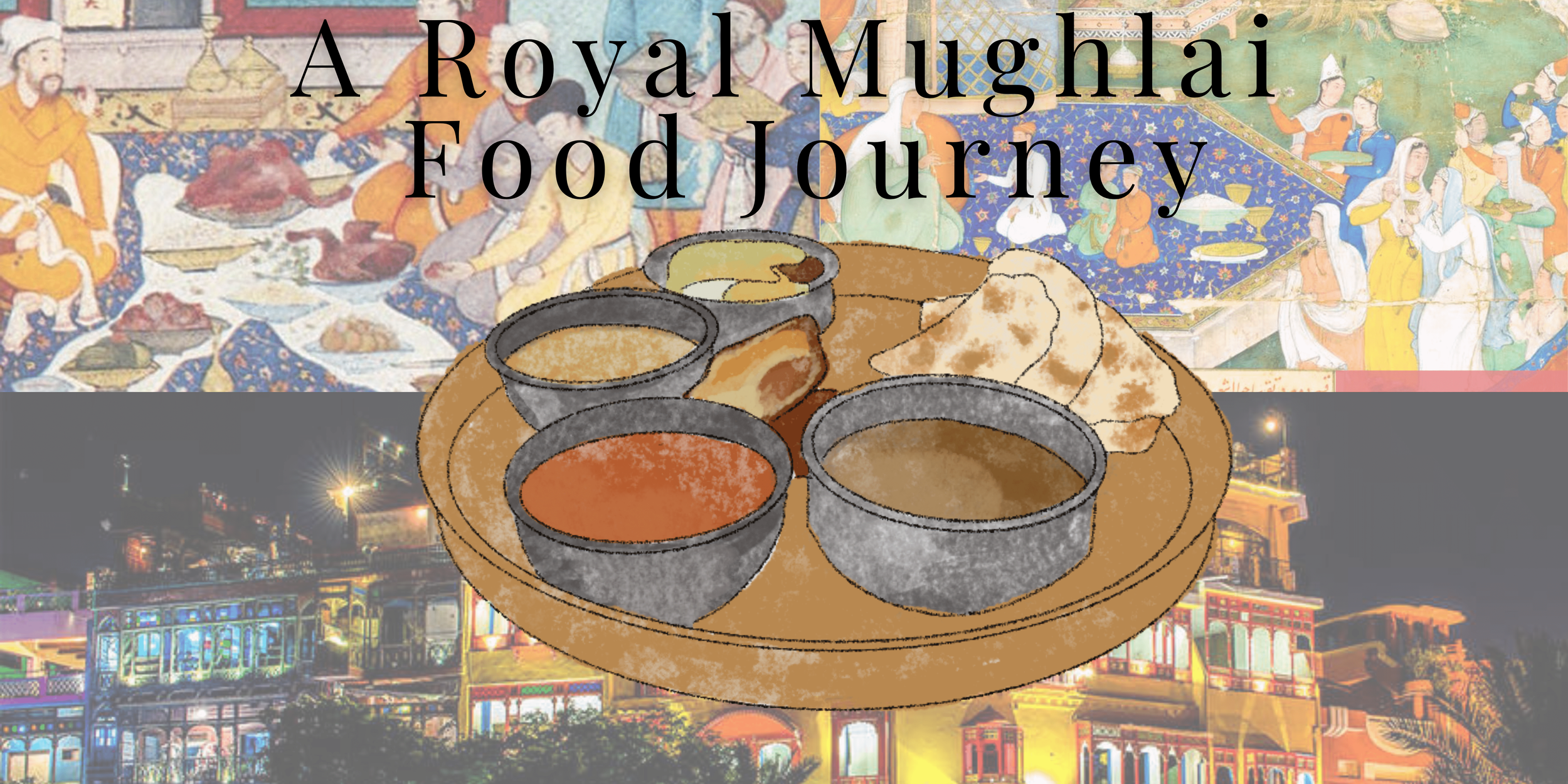A Royal Mughlai Food Journey
The city my parents were born in, Lahore, is an ancient city. Despite the density of the population and the sheer number of people inhabiting it, Lahore carries stories and legends that spread across centuries. Because of this, one of my favorite places to visit in Lahore is its Andaroon Shehr (walled city) and Food Street.
Zoha at “Haveli restaurant” within the Lahore Food Street.
Food Street, in particular, is a celebration of the impact of these timeless cultures and traditions in the form of food. In a single bite, one can experience delicious spices and flavors, along with the significant history of thousands of years. This area of Lahore is full of Mughal Era buildings, architecture, and alleyways, used by not only the emperor and his household, but by the average citizens, a tradition that continues today.
The Mughal Empire was established in South Asia in 1526 by Babur, a descendant of Timur and Genghis Khan from Uzbekistan, after defeating Ibrahim Lodi in the Battle of Panipat and dismantling the Delhi Sultanate. From its inception, the Mughal Empire’s culinary preferences became an integral part of court culture. These preferences continue to impact food traditions today. Babur, who was ethnically a Turk, migrated into the subcontinent from Central Asia. Thus, he preferred the Uzbek food from his homeland of Samarkand. This, mixed with the already present traditions in South Asia, birthed modern South Asian cuisine.
Mughal emperors became obsessed with mangoes, which were not native to their ancestral homeland. They began gifting mango trees for political gain, fighting over them, grafting them, and cultivating them. To this day, mangoes are the national fruit of India and Pakistan!
The second Mughal emperor, Humayun, was exiled to Persia for some time during his reign. Upon his return to South Asia, he brought in several Persian court influences. Humayun’s Persian wife Hamida, in the 16th century, introduced the use of dried fruits and saffron to the Mughal kitchen. Emperor Humyaun also loved to drink sharbat, a juice commonly made from fruits and flowers, concentrated into a syrup form. Drinking different kinds of sharbat including watermelon and more is a favorite pastime of South Asians today.
1910 portrait of Hamida Banu Begum, the second wife of Emperor Humayun.
The subsequent Mughal emperors with their taste for the lavish, further innovated in the kitchen, melding together several different cuisines styles from regions all over South and Central Asia. This is because members of their household and their court were from these areas and their traditions from their homelands made way for creating a new “royal cuisine.”
Common Mughal-influenced dishes today include biryani, pulao, kebabs, and kofta. The strong influence of Mughal cooking styles is evident throughout these dishes as the Mughals left a lasting impact on South Asia. The preparation of food and techniques used are still utilized today. They include:
Lengthy preparations - marinations in yogurt and spices, stews, and curries are brewed for long periods
Use of tandoor - a cylindrical cooking oven using charcoal and fire.
Meat-based
Spicy and fragrant!
Dried fruits and nuts in desserts and main courses
Dairy to mellow the spices.
Salma Yusuf Husain, a food historian, translated a cookbook from Shah Jahan’s era, the fifth Mughal emperor, called “Nuskha-e-Shahjahani.” In an interview with Vogue India, she mentions:
“Mughals brought a rich gastronomic history to India with them, and this influence is now an interesting part of our food culture. They brought style and substance to India’s simple food, making it exotic and turning cooking into art–the use of nuts and saffron, for example. Similarly, using fruits in cooking brought out a completely different flavor. Apart from this, their hospitality was legendary as well. They have left behind a legacy of food that remains alive even after centuries.”
Salma Yusuf Husain’s translated work The Mughal Feast.
Below is a recipe for “Zeer Biryani Paneer (rice with cottage cheese and green gram),” included in the “Nuskha-e-Shahjahani,” translated by Salma Yusuf Hussain.
Zeer Biryani Paneer
Serves: six to eight
Ingredients
Rice, four cups (1kg)
Cottage cheese (paneer), one cup or 250gm, cut into ¾ cubes
Wholewheat flour (atta), eight tsp or 40gm
Salt, eight tsp or 40 gm
Yoghurt (dahi), ½ cup or 125gm, hung and whisked
Saffron (kesar), 1.5gm, dissolved in water
Green cardamoms (choti elaichi), ½ tsp or 3gm, crushed
Onions, ½ cup or 125gm, sliced
Ginger (adrak), four tsp or 20gm, crushed
Cinnamon (dalchini), ½ tsp or 3gm
Cloves (laung), ½ tsp or 3gm
Black peppercorns (sabut kali mirch), 1.5gm, ground
Ghee, 1½ cups or 375gm
Green gram (cholia), ½ cup or 125gm, fresh and washed
Flat bamboo sticks as needed
Method
Mix the wheat flour and salt with water in a bowl to make a thick batter. Cover the cottage cheese pieces with this batter and deep fry until golden brown. Keep aside.
Mix the whisked yogurt with the saffron and half of the finely crushed cardamom seeds. Apply this mixture over the fried cottage cheese pieces
Take a wide, thick-bottomed pan, and arrange flat bamboo sticks in a criss-cross way at the bottom.
Remove the cottage cheese pieces from the yogurt mixture and place them over the bamboo sticks. Place the onion slices along with ginger, cinnamon, cloves, ground pepper, and ¾ cup ghee over the cottage cheese pieces.
Parboil the rice and spread it over the cottage cheese pieces. If the rice is a little hard, sprinkle two tbsp water to make it soft. Color some rice with saffron and put it on one side of the pan.
Spread the green gram over the rice.
Heat ¾ cup ghee to the smoking point, and pour around and on top of the rice. Place one cup of wheat flour on top of the rice, cover, and seal the pan.
Place live charcoal on the cover of the pan and put on dum (slow-pressure cook) for five minutes.
The next time you dive into a fragrant bowl of spicy biryani, chomp into juicy kebabs or enjoy the nutty addition to desserts like kheer (rice pudding), eat knowing that you are eating the food of the royals. Food that glued together one of the greatest empires of the subcontinent. Food that is not only representative of the diversity at its time, but also a representation of the diversity of the entire subcontinent today.
16th-century miniature painting depicting Babur at a banquet feasting on a roasted goose.





